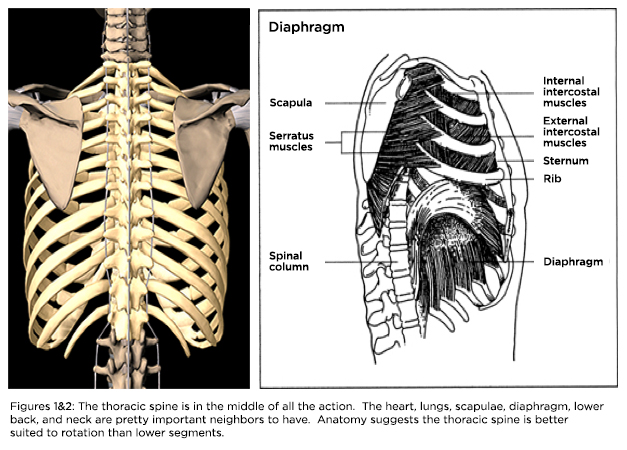IMPROVE MY GAME
Articles
How To Improve Rotation While Protecting Your Lower Back
The thoracic spine is often a neglected section of twelve vertebrae stuck between the much more talked about lumbar spine and the forever-painful cervical spine.

By definition, the thoracic spine is the twelve vertebrae that connect with the rib cage and is located between the lumbar spine and the cervical spine. Because we rarely get thoracic pain we tend to overlook this critical area. Neck and low back pain are rampant so the thoracic spine is often completely overlooked. Unfortunately a big key to avoiding both lower back pain and neck pain may lie in the mobility of your thoracic spine.
In the simplest terms, the body does what is easy, not what is best. As we age the thoracic spine stiffens. As a result we tend to turn the head at the neck (cervical spine) or rotate at the lower back (lumbar spine). A mobile thoracic spine can help to avoid or relieve both low back and neck pain by allowing rotation in this key area.
In the simplest terms, the body does what is easy, not what is best.
For years we have been warming up the wrong area with the wrong exercises. Lots of “experts” recommended exercises like hip crossovers and scorpions to “warm-up” the low back.
Here's a video I put together for Golf Digest discussing common "rotational" exercises that are probably doing more harm than good.
The video was essentially a spin-off of an article I wrote a few years ago titled "Is Rotation Training Hurting Your Performance?" In the article I recommended that athletes, particularly golfers, avoid most exercises that rotate the lumbar spine and instead focus on developing motion at the hips and thoracic spine. The truth is that good motion in golf comes from turning the hips and the shoulders not from rotating the lumbar spine. In her book, The Diagnosis and Treatment of Movement Impairment Syndromes, author Shirley Sahrmann notes a key fact that I believe has been overlooked in the performance field:
"The overall range of lumbar rotation is ...approx 13 degrees. The rotation between each segment from T10 to L5 is 2 degrees. The greatest rotational range is between L5 and S1, which is 5 degrees…The thoracic spine, not the lumbar spine should be the site of greatest amount of rotation of the trunk… when an individual practices rotational exercises, he or she should be instructed to "think about the motion occurring in the area of the chest"
(Sahrmann, p61-62)
Therefore, a way to get good hip motion and good shoulder turn is to focus on the hips and thoracic spine, not the low back. Bottom line, bad golfers turn at the low back. Good golfers turn at the hips and shoulders.
Additionally, the ability to resist or to prevent rotation may in fact be more important than the ability to create it. Clients or athletes must be able to prevent rotation before we should allow them to produce it.
As I mentioned in the video above, golfers should seek to improve internal and external rotation of the hips. Exercises like the Comerford Hip Complex, a progression developed by Australian physio Mark Comerford, strengthens the rotators of the hips and improves lateral stability in your golf swing.
Comerford Hip Complex
Mobility at the thoracic spine is actually simpler to develop than you think. It doesn’t even involve rotation. What you are going to do to mobilize the thoracic spine is to perform a series of simple crunch type exercises while lying on two tennis balls taped together with masking tape or your can even put them in a sock. It's a simple exercise that you can do at the gym or even in front of the TV. Dr. Rose demonstrates in the following video:
Tennis Ball Thoracic Spine Mobility
Place the tennis balls under your back with one ball on either side of the spine. Begin at just above bellybutton level. With the balls in position do five crunches. You should feel the balls pushing into your spinal erectors (the big muscles on either side of the spine). The balls are actually pushing the vertebrae slightly forward, in effect creating motion (mobility) at the level of that segment. A series of these crunches can be done all the way to the top of the shoulder blades. The end result is often a large increase in shoulder turn. Another possibility is to foam roll the thoracic spine. Make sure the elbows are together to separate the shoulder blades and get pressure on the thoracic spine.
If you are bothered by low back pain, neck pain or want more shoulder turn try the attached mobility exercises. Just remember, it’s not always where it hurts that needs the attention. Often times it’s the joint above or below.

Michael Boyle is a Boston-based strength and conditioning coach and one of the world’s foremost experts in what is now called FunctionalTraining. Michael’s products are available at www.performbetter.com